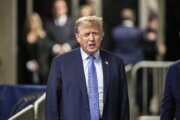Excerpts from recent editorials in the United States and abroad:
Sept. 23
The Washington Post on the U.S. feeding children in 2023
The children’s names rarely make the news. They are the millions of kids in Somalia, Libya, Mali, Haiti, Afghanistan, Yemen and other poor nations who don’t have enough to eat. They were born into families that make less than $2.15 per person a day. Their plight has worsened as food prices around the world have soared because of global inflation, natural disasters and war, especially Russia’s unjust invasion of Ukraine, in which Russian President Vladimir Putin has attempted to block one of the world’s critical grain supplies from reaching many of the neediest nations.
The United States last year rallied other countries and wealthy families to ensure 160 million of the world’s neediest had enough to eat. The job needs doing again.
What sets the United States apart as a global leader is more than military might; it’s how this nation steps up in moments of global crisis, including times of hunger and famine. As Secretary of State Antony Blinken said this month, “The United States is the largest donor in the world to the U.N. World Food Program. We provide about 50 percent of its annual budget. Russia and China? Less than 1 percent each.”
This year brings another moment of crisis. Food prices remain high, Russia continues to thwart Ukrainian grain shipments, and a spate of earthquakes and severe floods have caused more nations than usual to request emergency assistance. Roughly 345 million people are in dire need of food aid, according to the U.N. World Food Program. That is virtually the same as the record set last year, yet funding has been slashed. There is no other way to say it: Millions will go hungry if the U.N. World Food Program does not get more funding. Its total budget for 2023 is $5 billion, the lowest since 2015 and less than half of the $14 billion the agency had last year as donors have become fatigued.
Some question why the United States sends money overseas to feed the world’s poorest when there are many needs at home. This is a false choice. This nation can help its own people and play a leading role in preventing starvation around the world. Last year, the United States spent about $119 billion on the domestic food stamp program and gave about $7 billion to the U.N. World Food Program. This year, the United States has given the program just $2.1 billion, its smallest contribution in years.
There are reasons beyond a moral imperative to sustain high levels of foreign food aid. A Presidential Commission on World Hunger was established in 1978. Then-first lady Rosalynn Carter took notes on the “significant reasons” eliminating global hunger was a top priority for the United States. Her first two bullet points were “moral obligation” and “national security.” These remain just as true today. When people do not have enough to eat, they often flee to other nations or join extremist groups who lure them with promises of food and change.
Foreign food aid, particularly on an emergency basis, need not be a permanent international welfare program. In 1978, when that commission began, nearly half the world’s population lived in extreme poverty. Today about 10 percent live in extreme poverty. In addition to giving emergency food aid, the United States has also been increasing its investments in helping low-income nations become self-sufficient with improved farming techniques through a program called Feed the Future.
Congress faces many needs, but an extra $3 billion for global food aid would make a powerful global statement, galvanize more giving and show the world why U.S. leadership is indispensable.
ONLINE: https://www.washingtonpost.com/opinions/2023/09/23/global-hunger-poverty-united-states/
___
Sept. 23
The New York Times on U.S.-China relations
The editorial board is a group of opinion journalists whose views are informed by expertise, research, debate and certain long-standing values. It is separate from the newsroom.
Many Americans, even once-ardent proponents of globalization, have soured on trade with China. But there is a growing danger that as the United States tries to address its difficulties with China, it will pull back too far, severing economic ties that benefit American families and contribute to global peace and prosperity.
The relationship problems are real, and cannot be minimized. Chinese industrial subsidies, often maintained despite promises to the contrary, stripped millions of jobs from America’s industrial heartland. Chinese companies flagrantly steal American innovations. China’s increasingly confrontational posture toward the United States and its allies — including the economic support it is providing for Russia’s invasion of Ukraine — have underscored the need for the United States to align trade policy more closely with other aspects of America’s national interest. In an example of the prevailing mood in Washington, Representative Mike Gallagher, the Wisconsin Republican who serves as the chairman of the pointedly named “Select Committee on Strategic Competition Between the United States and the Chinese Communist Party,” recently called for broad prohibitions on U.S. investment in China, writing in an essay published in The Washington Post that “we are quite literally funding our own potential destruction.”
A new rule book is needed. Too few leaders, however, appear willing to note that Americans also benefit from trade with China, that the two nations are economically intertwined whether they like it or not, and that it is in America’s interest for the rest of the world to prosper. Americans bought almost $40 billion of Chinese toys, games and sports equipment last year. Soybean farmers in the Upper Midwest sold a record $16.4 billion of their beans to China, mostly for pig feed. Intel takes profits from low-end chips it makes and sells in China to fund the high-end chips it sells in America and to its allies. Hundreds of millions of Chinese have come out of poverty thanks to global trade, and have become consumers of U.S. goods and services. Cummins, an engine maker based in Indiana, operates 21 factories in China, and earns a fifth of its profits from its operations there. “Our success in China has led to global success and U.S. job growth,” Jon Mills, a spokesman for the company, recently told the Times reporter Alexandra Stevenson.
Amid the harsh talk, the dollar value of American trade with China — Americans buying Chinese products and the Chinese buying American products — rose to a record in 2022. The goal of American policymakers ought to be safeguarding the vast majority of those trade flows while addressing the problems that have emerged.
The Biden administration’s top priority in its dealings with China is, as it should be, national security. The president has emphasized the need to limit China’s access to advanced technologies with military applications. An executive order recently signed by Mr. Biden that restricts American investment in Chinese firms that work on artificial intelligence, semiconductors and quantum computing is a measured and necessary intervention. The government’s push to provide subsidies for the domestic production of semiconductors is also a sensible policy. The United States needs to secure reliable access to critical materials.
Hawkish politicians from both parties and American companies that stand to gain from protectionist policies, however, are pushing for a broader retreat from trade with China. Donald Trump, whose dim view of trade helped to propel his successful presidential candidacy in 2016, and who is again the front-runner for the Republican presidential nomination in 2024, is promising to “tax China to build up America.” After the Biden administration suspended tariffs on some Chinese solar panels to accelerate America’s conversion to renewable energy, Senate Democrats and Republicans joined in a vote to reimpose the tariffs. “This vote was a simple choice: Do you stand with American manufacturers and American workers, or do you stand with China?” said Senator Sherrod Brown, Democrat of Ohio. Mr. Gallagher’s committee, with bipartisan support, has been investigating whether U.S. financial giants like BlackRock and MSCI invested in blacklisted Chinese firms, a warning shot aimed at Wall Street.
The Biden administration describes its approach to trade limitations as “small yard, high fence,” meaning that it is aiming to restrict China’s access to a small number of advanced technologies. But some strictures on trade, notably the broad tariffs on Chinese imports first introduced by Mr. Trump and maintained by President Biden, already go too far, imposing costs on American households without much benefit to them or national security.
Keeping the yard from getting bigger is also likely to prove difficult. During Commerce Secretary Gina Raimondo’s recent visit to China, the country’s leading mobile phone manufacturer, Huawei, provocatively released a new smartphone powered by an advanced chip made in China most likely using American technology and machinery. A group of House Republicans sent a letter to the Biden administration citing the phone’s release as evidence of the need for tighter restrictions on China’s access to advanced chips. But China’s ability to make serviceable smartphones does not threaten America’s national security. Restraint is the best policy here. The United States has a legitimate interest in limiting China’s access to military technology, not in preventing the Chinese from checking email.
And while high walls are sometimes essential, so too are broad bridges. It is important to create real penalties for bad behavior by China, but it is also important to reward good behavior. Just as in the United States, there is a debate inside China between trade hard-liners and reformers. America has natural allies among those in China who understand that Beijing has to change and can succeed by playing by the rules.
Defending trade is politically fraught in part because so many American leaders underestimated the impact of China’s rise on American workers and failed to ensure that the benefits were broadly shared.
That failure has changed Americans’ views of how our country relates to the rest of the world. A recent study reports that younger Americans are more skeptical than previous generations that trade is mutually beneficial for participating nations, part of a broader turn toward zero-sum thinking — the belief that gains for one group tend to come at someone else’s expense. The authors argue that the outlook of older generations was shaped by an era of higher growth, in which it seemed plausible that everyone’s boat would rise. Younger generations, by contrast, have been embittered, and policymakers can rebuild support for trade only by addressing those past failures.
The United States can do that by pursuing economic relationships with the world that include protections for the environment and for workers. Other nations will continue to provide industrial subsidies, and the United States can use similar policies to develop new industries, like the renewable energy sector. “We’re retaking control of our energy security and our energy future,” Ali Zaidi, Mr. Biden’s climate adviser, said in an interview with The Times’s editorial board. At the same time, America should continue to pursue deeper economic ties with allied nations, as in a recent agreement to allow electric vehicle batteries made with minerals from Japan to qualify for U.S. tax credits.
American engagement with China is complicated by China’s contradictions. The country remains eager for access to advanced technologies and global markets, but resists giving reciprocal access to its own markets. In recent months, even as China has ended pandemic restrictions and made a show of reopening its doors, it has made life difficult for foreign firms, with raids on corporate offices, for instance. Some measures, like the refusal of Chinese antitrust authorities to let the American chip maker Intel buy the Israeli chip maker Tower, appear to be responses to U.S. restrictions. But longstanding grievances remain unresolved. It has been 22 years since China promised to let Visa and Mastercard operate on equal terms, and 11 years since the W.T.O. ruled that China wasn’t keeping that promise, yet the companies still are struggling for access.
The best reason for optimism is that the two nations still depend on each other. China’s recent struggles — slowing growth, an imploding housing sector, high youth unemployment and capital flight — appear to be motivating a more open stance among Chinese policymakers. And after a period of escalating tensions, the Biden administration also has sought to calm the waters by sending a series of senior officials to the country. In recent years, Chinese airlines have largely refrained from placing new orders for Boeing airplanes, making a political point of buying jets from Airbus, its European rival. But Guillaume Faury, the Airbus chief executive, predicted in a recent interview that the trend would not continue. “I don’t believe that China can rely on one aircraft manufacturer,” he said. “They need competition.” The first narrow-body jets produced by a Chinese company, Comac, entered commercial service earlier this year. The engines were manufactured in Durham, N.C.
The steadily rising trade between the United States and China from 1979 to the present has disrupted the lives of many Americans and caused real harm to some. That said, in the sweep of history those four decades were an era of remarkable peace between, and prosperity for, the two countries.
Some U.S. politicians want to take advantage of China’s dependence to constrain its economic development by denying China the technologies that it needs. The better course is to focus on limiting the reach of China’s military, not its economy as a whole. China sees that it cannot isolate itself from the world; this is not the time for the United States to do so, either.
ONLINE: https://www.nytimes.com/2023/09/23/opinion/us-china-trade.html
___
Sept. 24
The Wall Street Journal on the Railway Safety Act
It pays to be wary of politicians rushing out legislation after an accident or disaster, and the Railway Safety Act is a classic of the genre. It uses February’s train derailment in East Palestine, Ohio, to enact a Big Labor priority.
The bill is courtesy of Ohio’s Senate duo, Democrat Sherrod Brown and Republican J.D. Vance.
Norfolk Southern railroad is covering the more than $800 million cost to clean up the hazardous chemicals, but the Senators say their bill is meant to head off future accidents.
Yet the bill’s main provisions are irrelevant to the Ohio rail accident and most others. Instead it maximizes work hours for union laborers and slaps mostly redundant rules on rail carriers.
The biggest union giveaway is a mandate requiring rail carriers with more than $1.032 billion in annual revenue to maintain two-person train crews. That would mean more jobs and longer hours for rail workers, and more dues for the union, but any safety benefit is speculative. The Federal Railroad Administration declined a crew-size mandate in 2019 after finding it would have no effect on safety, and the failed Ohio train had three men aboard. Yet the 12 rail labor unions have sought it for years.
The same goes for the bill’s handling of inspections. It mandates that railcars be inspected by a railroad-certified mechanic instead of a conductor, and it directs the Transportation Department to ban railroads from setting a maximum time limit for inspections. The result will be backed-up trains awaiting inspectors, but no visual check would have caught the heat failure that caused the Ohio derailment.
Sensors beat human eyeballs in detecting malfunctions, as shown in a pair of studies by consulting firm Oliver Wyman in 2015 and 2021. Rail carriers in recent years have focused on developing on-board technology for heat sensing and other common malfunctions, and the mandates will divert money that could finance future breakthroughs.
The biggest carriers already have two-man crews under their collective-bargaining agreements with the rail unions. Midsize carriers often don’t, however, and they would be hit hardest by new costs. Sens. Brown and Vance rushed their bill into draft after the Ohio crash, and they seem not have considered how its rules will burden rail shipping.
Mr. Vance has said he “privately” has enough Republican support to clear the 60-vote Senate filibuster rule. But let’s hope the months since the accident have given other Senators time to consider the merits rather than the easy politics. Majority Leader Chuck Schumer planned to schedule a full vote after the bill cleared the Commerce Committee in May, but only seven Republicans have said they would support it. It would also face a tough hurdle in the GOP-controlled House.
Lawmakers will always be tempted to follow a crisis with new laws they can take credit for, especially when the event is close to home. Yet there’s no excuse for passing an ill-considered law loaded with unnecessary priorities that cater to a political special interest.
___
Sept. 22
The Los Angeles Times on Kevin McCarthy and likely government shutdown
A shutdown of the federal government, even if only temporary, would needlessly disrupt the lives of public employees and citizens who depend on government services. But, despite a flurry of activity on Capitol Hill, such a calamity remains all too possible next month.
The explanation is tiresomely familiar: the obstructionism of a small band of hard-line House Republicans. On Thursday these dissenters embarrassed Speaker Kevin McCarthy by blocking consideration of a Pentagon funding bill, the second such vote in a week. Opposition from extreme right-wing members is also complicating McCarthy’s attempt to advance a continuing resolution, a stopgap measure to keep the government operating after Sept. 30.
Ideally McCarthy would be able to attract Democratic votes to protect the national interest, as he did in May when the House approved legislation to suspend the debt ceiling and forestall a default. That vote was a model of the sort of bipartisan compromise that should be the norm in a divided Congress.
But proposals by House Republicans for a continuing resolution — needed because of a lack of progress on specific appropriations bills — offer Democrats little incentive to come to McCarthy’s rescue.
The latest proposal, discussed at a House Republican conference meeting on Wednesday, reportedly is for a 31-day stopgap funding bill that would impose limits on spending more restrictive than what Democrats want and include measures to curb immigration. McCarthy has sought to link the stopgap measure to some of the provisions of a bill passed by the House, which includes a resumption of construction of a border wall and restrictions on asylum.
Even if Democrats were willing to support a continuing resolution, a decision by McCarthy to rely on Democratic votes probably would increase the possibility of an attempt by extreme Republicans to unseat him from the leadership role he narrowly achieved on the 15th ballot.
An additional complication is the decision by former President Trump, who is a favorite of many House Republicans, to inject himself into the shutdown debate. On Wednesday Trump posted this call to arms on Truth Social: “A very important deadline is approaching at the end of the month. Republicans in Congress can and must defund all aspects of Crooked Joe Biden’s weaponized Government that refuses to close the Border and treats half the Country as Enemies of the State. This is also the last chance to defund these political prosecutions against me and other Patriots.”
(In fact, it’s unlikely that a shutdown would interfere with the federal prosecutions of Trump. Just add that to the ever-growing pile of the former president’s lies and distortions.)
McCarthy might still cobble together enough votes to win the support of a majority of Republicans for a continuing resolution, which would then have to be reconciled with or replaced by what is likely to be a less extreme Senate version.
Yet if dissenters continue to stymie his efforts, the speaker should stop accommodating them and reach out to Democrats as he did when he secured an agreement with the White House on suspending the debt ceiling. By now McCarthy should have realized that placating the extremists in his ranks — including by announcing a meritless impeachment inquiry into Biden — only emboldens them.
ONLINE: https://www.latimes.com/opinion/story/2023-09-22/government-shutdown-mccarthy-extremists
___
Sept. 25
China Daily on the U..S-Pacific Island Forum Summit
The US-Pacific Island Forum Summit US President Joe Biden is hosting in Washington on Monday and Tuesday is the second such gathering. It has apparently failed to fire the same enthusiasm among the Pacific island countries as the first.
Not only have the leaders of two major countries in the region — Solomon Islands Prime Minister Manasseh Sogavare and Vanuatu Prime Minister Sato Kilman — skipped the summit, but even some of the other non-US participants seem lukewarm about the event.
After the first summit, the White House said the United States would invest more than $810 million in expanded programs to aid the Pacific islands. However, Congress has still to approve the funds. Yet what the Pacific island countries have received posthaste is diktats from the US, with visiting officials of the Biden administration telling them the dos and don’ts.
White House “Indo-Pacific” coordinator Kurt Campbell and the State Department’s top officials for Asia visited the Solomon Islands in April last year, urging it to reconsider the cooperation pact it had signed with China. They visited the country again in March this year for the same purpose. Last month, two Republicans from the US House of Representatives, one being a member of the select committee on strategic competition with China, met with opposition leaders in the Solomon Islands, seeking to cultivate pro-US proxies.
That the high-level interagency mechanism the US Department of State has set up for the US’ aid to the region mainly comprises officials of the National Security Council and the Department of Defense speaks volumes of the fact that infrastructure aid is only a cover for the US’ true intention of excluding China from the region. For example, Kiribati, one of the most remote Pacific island states, 4,000 kilometers southwest of Hawaii, is still using an airstrip built during the World War II. But when it said this year it plans to upgrade it with Chinese assistance, the US tried to block the project.
And when the Pacific island countries were in a dire need of essential medical supplies during the COVID-19 pandemic, the US was deaf and blind. Yet it is quick to respond whenever it sees China extending a helping hand to countries in the region or hears of it planning to do so.
Nor should it be forgotten that the US has not yet fulfilled its responsibility to compensate the losses of the Marshall Islands caused by its hundreds of nuclear tests in the region in the 1940s and 1950s. That is in sharp contrast with the efficiency and zeal of Washington renewing agreements this year with Palau and Micronesia that give it exclusive military access to strategic parts of the Pacific.
For the US, the Pacific island countries are simply pawns to be played in its geopolitical games. If the US truly cared about their development as Biden claims, it would not only honor the pledges of assistance it made at the first summit but also repay its historical debt.
ONLINE: https://www.chinadaily.com.cn/a/202309/25/WS6511844fa310d2dce4bb7b91.html
Copyright © 2024 The Associated Press. All rights reserved. This material may not be published, broadcast, written or redistributed.







